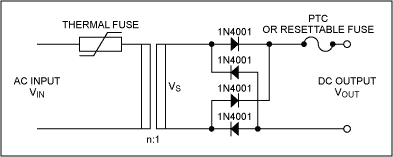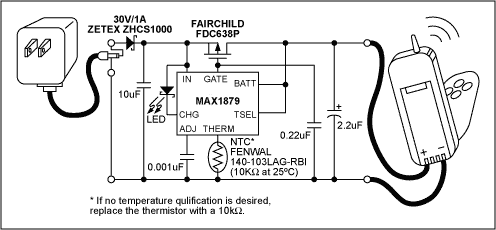Introduction
Many handheld devices are using a single-cell Li+ battery, and they demand a simple and economic charging solution. A cradle charger is one choice and it is getting more attention from system design engineers because they do not need to worry about built-in charging logic in their handheld devices. The cradle charger provides a complete standalone Li+ charger solution.
This application note describes an inductorless and virtually lossless single-cell Li+ cradle charger using a low-cost linear adapter.
Linear Input Power Supply for the Cradle Charger
Figure 1 depicts a block diagram of the off-line cradle charger. In the off-line cradle charger market, vendors use a separate AC/DC adapter or built-in AC/DC conversion in the cradle enclosure. The most economic solution for the AC/DC adapter is a linear transformer.

Figure 1. Off-line cradle charger block diagram
As shown in Figure 2, this simple linear AC adapter does not have a voltage and current regulation circuit, but if the AC input voltage variation and the output impedance of the AC linear transformer adapter are known its output characteristics can be predicted.

Figure 2. AC linear transformer adapter block diagram
Figure 3 shows the equivalent circuit diagram of the Figure 2 linear transformer. ZOUT is the output impedance of the AC linear adapter.

Figure 3. Equivalent circuit diagram of the linear transformer adapter
We can design a transformer that has a turn ratio n.
n= NP/NS= VIN/VS
If VIN=120Vac and VS=12VAC, then n is 10. If the VIN's variation is ±10%, the Vs will vary ±10% as well.
The output voltage of the Figure 2 adapter at RLOAD:
VOUT = (1/n) × VIN × RLOAD/ (ZOUT + RLOAD)
For example, if VOUT1 = 9V at 1mA and VOUT2 = 4.5V at 500mA load under the nominal AC input, the output impedance of the AC linear transformer adapter should be
ZOUT = (VOUT1 - VOUT2)/(500mA - 1mA)
= (9 - 4.5)/ 0.499
= 9Ω
Figure 4 shows the output voltage and current characteristics of an example linear adapter, rated input = 120VAC 60Hz and output = 3.7V at 350mA, that was designed as in Figure 2.

Figure 4. Output characteristics of a 3.7V at 300mA linear adapter
| Output Load | Output Voltage (Vrms) |
| 0A | 7.812V |
| 100mA | 6.218V |
| 200mA | 5.160V |
| 300mA | 4.140V |
| 400mA | 3.160V |
| 500mA | 2.120V |
| 600mA | 0.99V |
| 670mA | 0V |
Since the output voltage and current are limited, the output power is limited. Even though this linear AC adapter has poor line and load regulation, it is a very good choice for the input power supply of the MAX1879 Li+ charger. The thermal fuse and the PTC (positive temperature coefficient) resistor in Figure 2 may be used for over-temperature protection and UL safety requirements.
The MAX1879 Li+ Charger
The MAX1879 battery charger for a single-cell Li+ comes in an 8-pin µMAX package. This device, in conjunction with the AC linear transformer adapter and a PMOS FET, allows safe and fast charging of a single Li+ cell. The MAX1879 is not only an inductorless required solution, but also the lowest power dissipated solution among single-cell Li+ battery chargers. Figure 5 shows an actual application circuit, which includes a charging state LED, a thermistor, and a reverse current protection diode.

Figure 5. The MAX1879 high efficient Li+ charger
The MAX1879 initiates charging in one of three ways: battery insertion, charger power-up, or external manipulation of the THERM pin. CHG\ LED turns off when the on/off duty cycle falls to 1/8, and charging terminates when the on-chip counter times out. Key safety features include continuous voltage and temperature monitoring, a programmable charger time-out, and a 8mA precharge current mode to charge near-dead cells. Automatic detection of input power removal shuts down the device, minimizing current drain from the battery. An overall system accuracy of 0.75% ensures that the cell capacity is fully utilized without cycle life degradation.

Figure 6. The output waveform of the 3.7V at 350mA AC adapter and the charging current with the MAX1879 charger shown in Figure 5
Summary
The MAX1879 with a current limited linear wall adapter can produce the most economic and efficient solution for the single-cell Li+ off-line cradle charger, with virtually no power loss on the PMOS FET. It can be easily designed for handheld devices or battery packs without excessive power dissipation and heat problems.




















